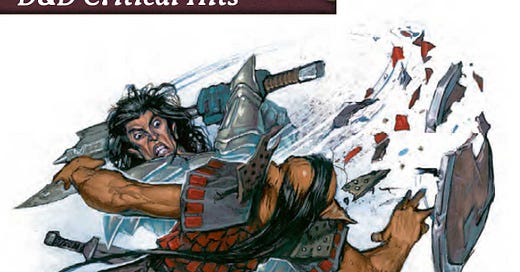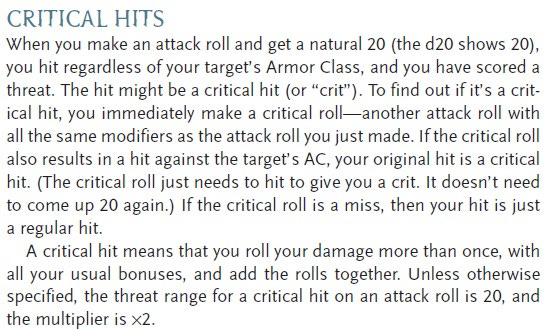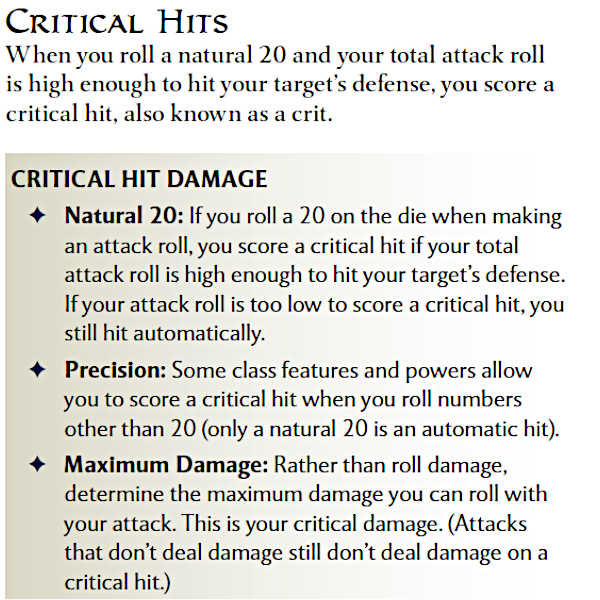The party is exhausted. You just drank your last healing potion. The bodies of dead enemies lie strewn about the battlefield. You stand toe-to-toe with the beholder—or you would be if it had toes. Your counterparts have gotten in some nice hits and now they look to you, the barbarian, to finish off this villain once and for all.
You raise your battleaxe and bring it down with all the strength you have left. The d20 bounces across the table and, after spinning for a perilous moment around the eight, settles solidly with the twenty shining up at the sky.
The table lets out a celebratory cry of victory. But what happens next? Well, that depends on what game you are actually playing.
We often spend so much time playing one particular variant of the game, we can forget that some rules are vastly different in the other editions—if the rule exists at all. Rolling a natural 20 on an attack is one such example of a situation that can mean different things in different editions of D&D. Let’s take a look at some of the variants.
D&D 1e
I could not find any references to anything special happening when a natural 20 was rolled in any editions prior to 2e. I checked the OD&D, AD&D, B/X, and BEMCI rule books and came up empty.
If anyone knows anything different in the official rules for these editions, please share.
D&D 2e
By my reckoning, this was the first edition of the game that included a rule for rolling a natural 20.
The rules indicate that a natural 20 on an attack is an automatic hit. That’s it. No critical hit. No extra damage. And to further minimize the impact of such a roll, the rules even indicate that the DM has the discretion to ignore this rule altogether.
Nevertheless, 2e was our first taste of something that would become iconic in the world of D&D combat.
D&D 3e
This includes D&D 3.5e as well as Pathfinder 1e as they all share the same rules.
In each of these games, a natural 20 is always an automatic hit, but we also get introduced to a new concept known as a critical hit.
After rolling the natural 20, you roll the attack again. If the second attack result is enough to hit the enemy, then you score a critical hit. The second attack does not need to also be a natural 20. It just needs to be enough to hit the target.
If the second attack fails, then you still have a normal hit and roll normal damage.
But if that second attack succeeds, you score a critical hit and get to deal some amazing damage. You roll your attack damage dice twice and then double the modifiers as well.
D&D 4e
4th Edition simplified the natural 20 rules a bit.
If you roll a natural 20 and the result, after adding your attack modifiers, is enough to hit the target, then you score a critical hit. If the result is not enough to hit the target, you still get a regular hit.
For critical hit damage, you do not even need to roll. You get the maximum for the weapon die and then add your damage modifiers.
D&D 5e
The rules around critical hits did not change between the 2014 and 2024 rules.
5th Edition simplified the rules even further.
A roll of a natural 20 on an attack is a critical hit. Hard stop. No need to add any modifiers or roll anything additional. For damage, you roll the attack damage dice twice and then add the damage modifiers once.
If you are looking for my completely unbiased opinion, ☺, 4th edition is a nice balance. Once you roll the natural 20, you do not need to roll anything else. There is no need to confirm that it was a critical and you do not even need to roll attack damage. You just get the maximum. Makes things much faster.
What are your thoughts?
If you made it this far, then you truly are a hero. If you would like to support the newsletter and keep it free for everyone, please consider using these links when you make purchases from these places…
The above affiliate links help to support the channel at no additional cost to you.












AD&D rules attack charts have 6 levels where a 20 will hit but above that they continue to 21 and up so that a unmodified natural 20 would miss. For a 1-2 level fighter the 20s range is from 0 to -5 so to hit a -6 AC at that level you would need a 20 plus 1 from something such as STR or magic weapon.
The only special thing about rolling a 20 I know of is for sword of sharpness or vorpal weapon. You actually get a bonus from the sword’s enchantment so you can sever on as low as an 18 for sharpness & 17 for vorpal swords. A 20 lets you sever solid metal or stone with either blade.